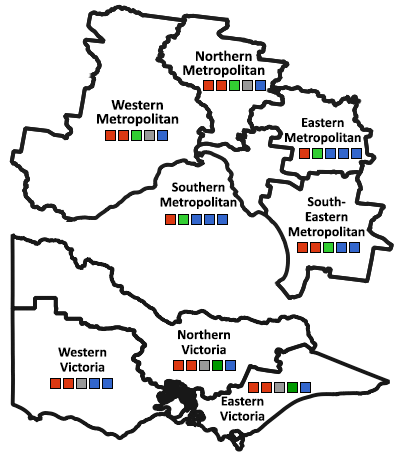Legislative Council |
||||||||||||||||||||||||||||||||||||||||||||||||||||||||||||||||||||||||||||
The election will be the fourth held under the current system for the Legislative Council, which divides the state into eight regions of five members, including five regions in Melbourne and three covering the regions. The PR-STV electoral system is familiar from the Senate, excepting that the group voting tickets system remains unreformed. Previously the state was divided into provinces consisting of four lower house districts, each of which had two members elected at alternating elections for double-length terms. This excluded minor parties and never quite availed Labor of a majority until Steve Bracks' landslide win of 2002, which resulted in the reforms that took effect in 2006. The eight regions include five in Melbourne and three covering the regions. In Melbourne, the left parties win majorities in Western Metropolitan, Northern Metropolitan and, more precariously, South Eastern Metropolitan, while the Liberals do so in Eastern Metropolitan and Southern Metropolitan (except in 2006 in the latter case). The Greens have never won a seat in any of the country regions, which have been remarkably consistent in each returning two Labor members at all three elections held under the current system. Micro-parties deprived the Coalition of third seats in each country region in 2014, having previously only done so with the DLP's win in Western Victoria in 2006. The first election under the new system gave the first three Greens ever elected to the Victorian parliament the balance of power, and also turned up a surprise when the Democratic Labor Party gained a seat, having last graced an Australian parliament in 1974. The 2010 result suggested this was aberration, as the incoming Liberal-Nationals government secured a majority and the Greens monopolised the cross-bench. However, the micro-party revolution truly arrived in 2014, when the number of candidates swelled from 209 to 351 as familiar electoral entrepreneurs arrived to stake their claim. Their combined share of the vote rose in due proportion, and micro-party candidates were elected in each of the three country regions and two of the five metropolitan regions, with vote shares ranging from 1.3% to 3.5%. With the Greens also expanding from three seats to five, the incoming Labor government faced a radically changed upper house in which the cross bench accommodated five parties and accounted for a quarter of the seats. Winning votes against a Coalition united in opposition has required the Greens as a necessary precondition, along with two of the five micro-party members, of whom only Fiona Patten of the Sex Party, since renamed the Reason Party, could be identified as left of centre. Shooters Fishers and Farmers have had two members, Jeff Bourman and Daniel Young, who have remained united throughout the term; Rachel Carling-Jenkins, who has progressed from DLP to Australian Conservatives to independent; and James Purcell of Vote 1 Jobs, effectively an independent. The latter two will contest lower house seats at the coming election. |
||||||||||||||||||||||||||||||||||||||||||||||||||||||||||||||||||||||||||||
 VICTORIAN ELECTION 2018
VICTORIAN ELECTION 2018
